Home / How To Draw A Bond Rotation
Stereochemistry and Chirality
How To Draw A Bond Rotation
Last updated: December 14th, 2023 |
How To Draw A Bond Rotation
- Rotation can happen to an infinitesimal extent around carbon-carbon single bonds but for the most part we only really care about showing rotations in 60 degree increments. This keeps two groups in the plane of the page.
- Rotations of +120° or -120° can be shown simply by interchanging any three groups on a carbon. If the carbon is a chiral center, take special care that 3 groups are interchanged, otherwise this will result in inversion of configuration (a “single swap”) on the chiral center.
- Bond rotations never result in flipping the absolute configuration of a carbon from (R) to (S) or vice versa, since that would involve breaking bonds. All that’s happening in a bond rotation is showing the molecule in a different conformation.
- Rotations of 180° are useful because they allow for rotation of the entire carbon chain. When you’re just getting started, applying some simple templates can help with getting things right, as will using a model kit (or even your hands).
- Rotations of +60° or -60° are necessary less often than 180° rotations, but they do use the same template as rotations of 180°.
- For situations where you need to rotate a large number of bonds at the same time, it’s often better to completely redraw the carbon chain and just make sure each chiral carbon has the same configuration in your “new” configuration as it does in the “old” one.
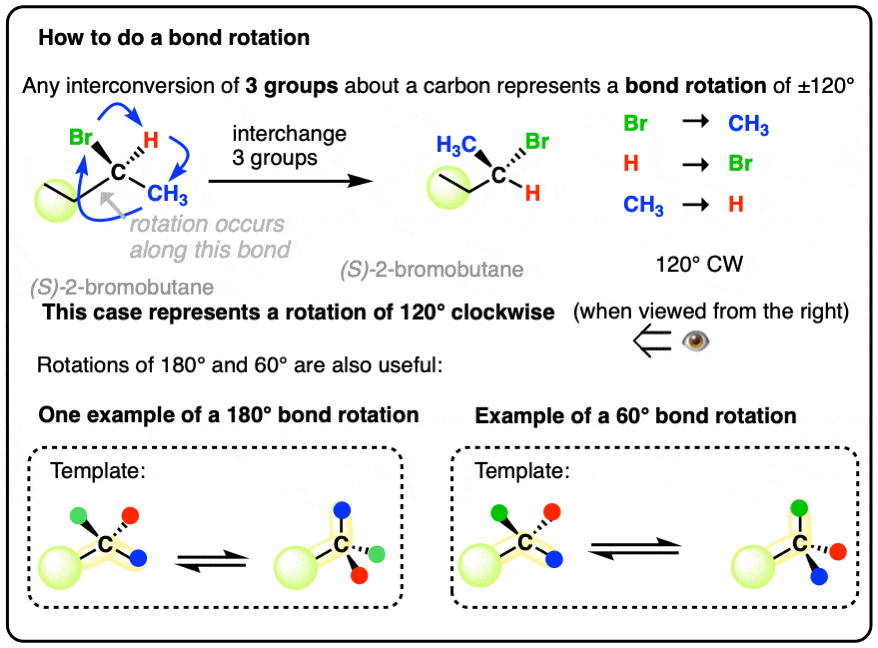
Table of Contents
- Bond Rotation Basics: Interchanging Any 3 Groups On Carbon Performs A 120° Bond Rotation
- Bond Rotation Practice
- 120° Rotations on Fischer Projections
- 180° Rotations: Two Templates
- Bond Rotation Practice (180°)
- 60° Bond Rotations
- Multiple Bond Rotations
- Summary
- Notes
- Quiz Yourself!
- (Advanced) References and Further Reading
1. Bond Rotation Basics: 120° Rotations
This article is to guide you through the times in your life when you need to draw a bond rotation.
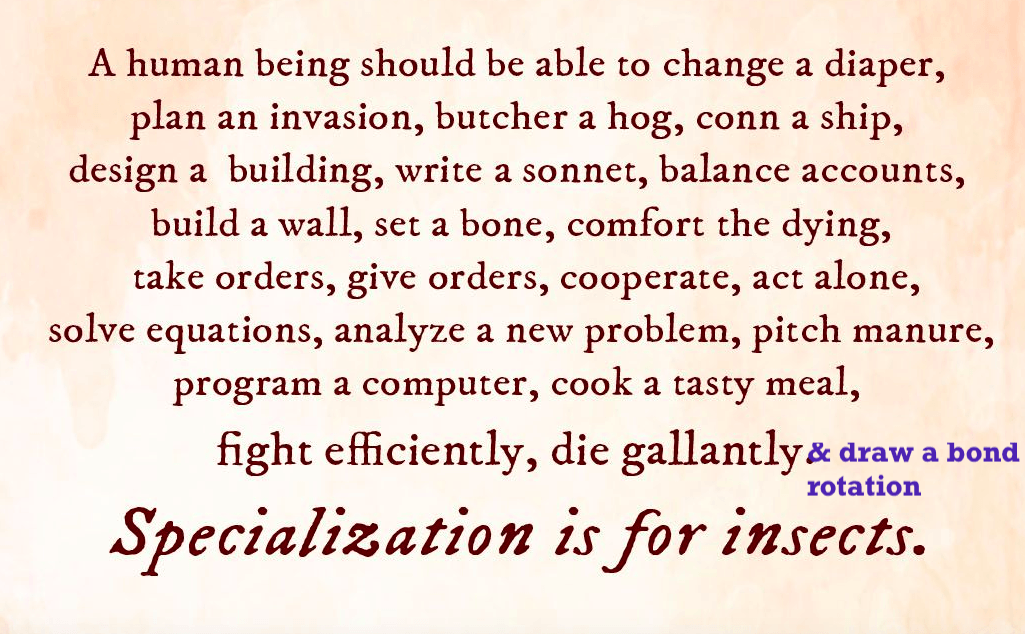
For most purposes, we are really only going to deal with the rotation of C-C bonds, but it can also apply to the rotation of other sigma bonds.
We will just do rotation of C-C sigma bonds in simple chains here, since 1) bond rotation in small rings is restricted [See Article: Introduction to Cycloalkanes] and 2) pi bonds cannot undergo free rotation.
Furthermore, although bonds can be rotated to an infinitesimal degree, we generally only care about showing bond rotations in increments of 60 degrees. This makes 3-dimensional molecules easier to depict on a flat piece of paper (or screen) since two of the four groups attached to tetrahedral carbon can be drawn in the plane of the page.
Since the carbon chain is drawn in the plane of the page 99% of the time, it follows from this we will focus on showing how to do rotations about one of the C-C bonds that is in the plane of the page.
Finally, I’m going to assume that you know that in our convention for drawing tetrahedral carbon, a wedged bond indicates that a group is pointing out of the page, while a dashed bond indicates a group is going into the page. [See article – The Wedge Dash Convention for Drawing Tetrahedral Carbon]
Also, for our purposes, it’s most important whether a bond is a dash or wedge. Not whether it’s pointing left or right. There are always two different ways of depicting the dashed and wedged groups (one on the right, one on the left) and they are equivalent. It’s just a matter of perspective which one we choose to draw.

With that out of the way, here is the first thing to know about bond rotations.
If you interchange any three groups on a tetrahedral carbon you will have drawn a bond rotation.
That’s it.
- You don’t have to think in 3-D.
- You are really just picking 3 symbols on a sheet of paper and interchanging them.
- You don’t have to even imagine you are doing a bond rotation.
- The net result will be a bond rotation of 120°, either clockwise or counterclockwise.
Let’s illustrate. Here is an isomer of 2-bromobutane. Let’s do a rotation about the C-C bond that connects the chiral carbon (C) with the ethyl carbon (marked by the green circle).
To do a bond rotation of 120°, all we need to do is interchange 3 groups: Br, H, and CH3 while keeping the fourth group (CH2CH3) in the same place.
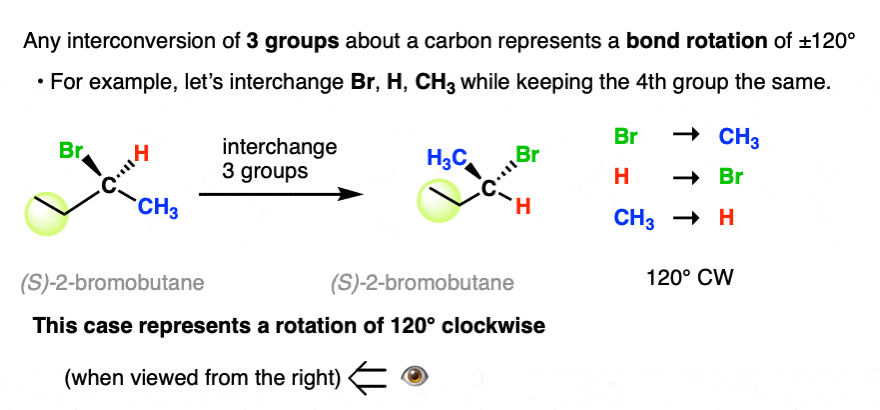
Woot! That’s it! We’ve done a bond rotation of 120° clockwise when viewed from the right.
It translates to this:
Alternatively, let’s start with the same molecule drawn slightly differently and do the same operation. (Note that in this example that the chiral carbon ends up on the “bottom” of the zigzag carbon chain, so the H and Br are pointing down instead of up. Completely identical molecule to the one drawn above, but a slightly different representation).
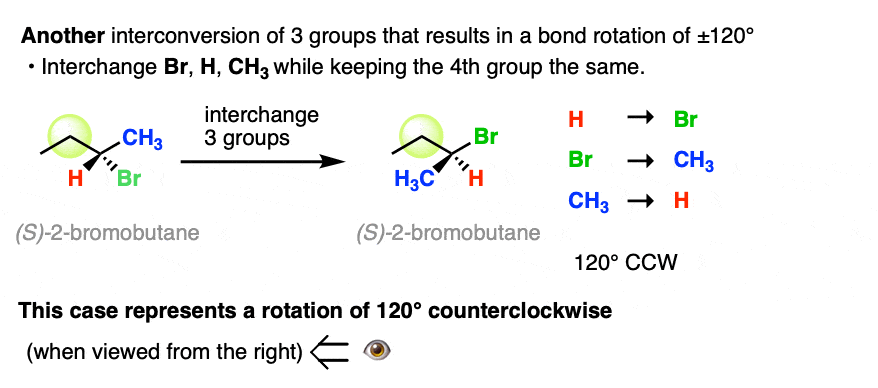
In this case we’ve done a rotation of 120° counter–clockwise (when viewed from the right) which is equivalent to a rotation of 240° clockwise.
(A key thing to notice is that the configuration of the chiral center does not change. It’s (S) on the left and also (S) on the right after bond rotation has occurred.)
That’s equivalent to doing this:

In each case we have performed a rotation of 120° or 240°.
I will leave it as an exercise to the reader to prove that interchanging any 3 groups on carbon leads to a bond rotation.
There’s just one extremely important thing to watch out for.
Only one group on the carbon should remain in its original position. The other three groups must be exchanged!
If you only exchange two groups, then you have not performed a bond rotation. Instead, you have inverted the configuration (i.e. you have broken some bonds).
Switching two groups on a chiral center will invert the configuration from (R) to (S) and vice versa. While this is also a useful trick of its own accord (See article: How to Draw the Enantiomer of A Chiral Molecule) it’s not a bond rotation.
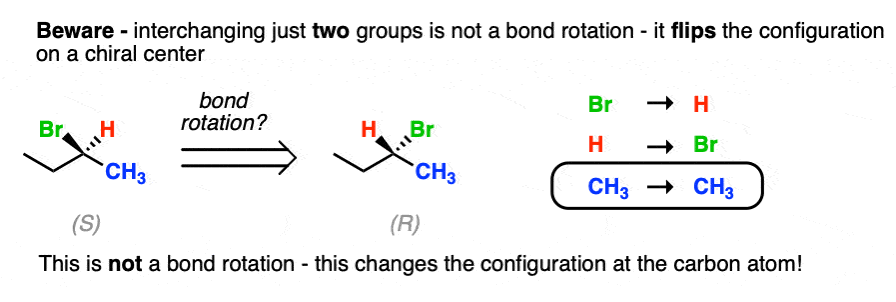
2. Bond Rotation Practice
Probably the most common instance of using a bond rotation comes up when determining the absolute configuration (R/S) of a molecule and being faced with a #4 ranked substituent (generally H) that is either on a wedge or in the plane of the page.
One way to put the #4 substituent in the back is to do a bond rotation. So let’s do two exercises in that vein.
In this case, the hydrogen is in the front. Show what the molecule would look like when the H is in the back (i.e. on a dash).
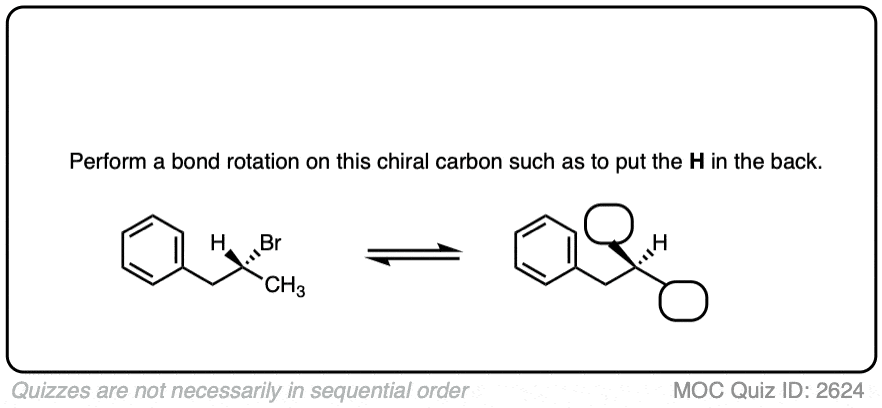 Click to Flip
Click to Flip
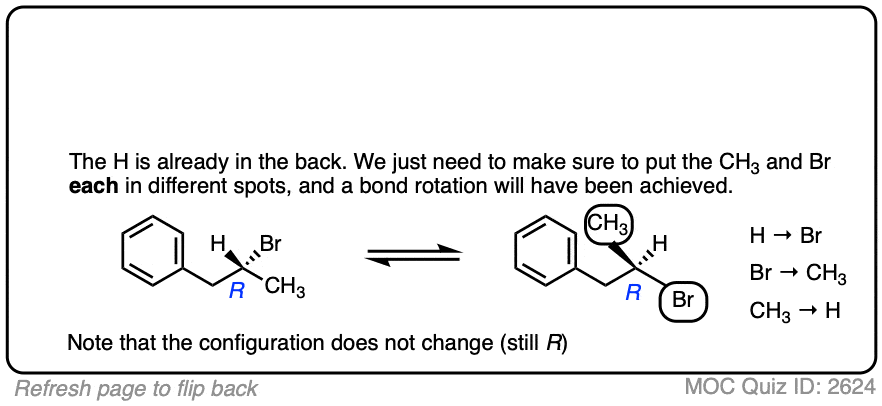
In the case below, the H is in the plane of the page. Do a bond rotation that would put it in the back.
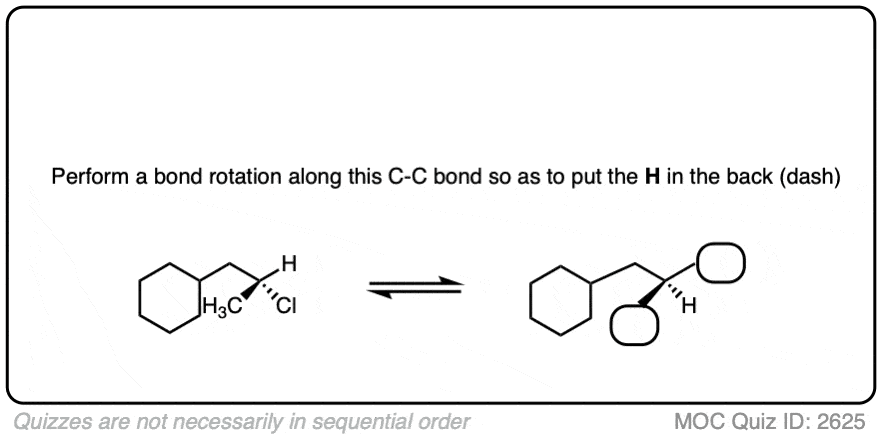 Click to Flip
Click to Flip
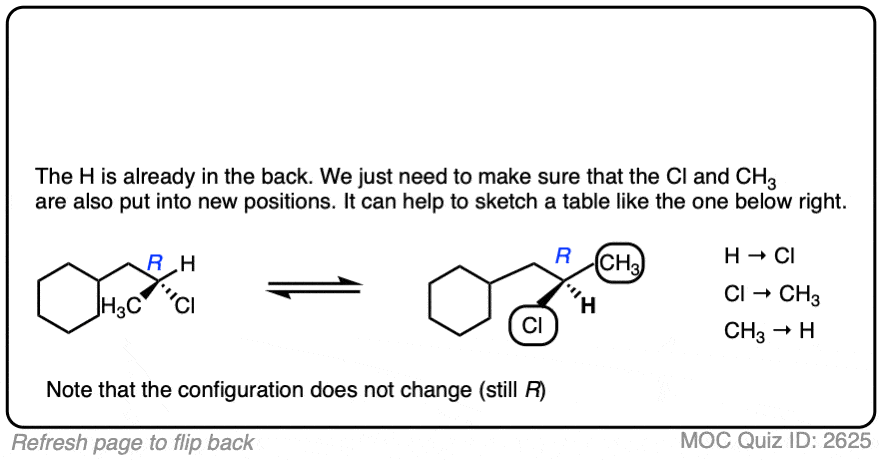
An alternative to doing a bond rotation is to learn to apply the Single Swap Rule, covered here – How To Draw The Enantiomer of a Chiral Molecule.
3. 120° Rotations On Fischer Projections
The technique of exchanging any three groups also works when the molecule is drawn from alternative perspectives, such as in the Fischer and Newman projections.
For instance, show how to do a bond rotation in this Fischer projection:
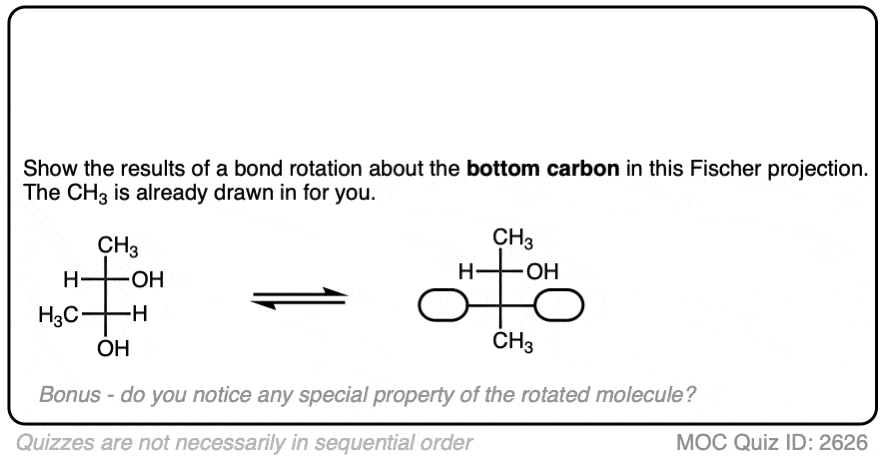 Click to Flip
Click to Flip
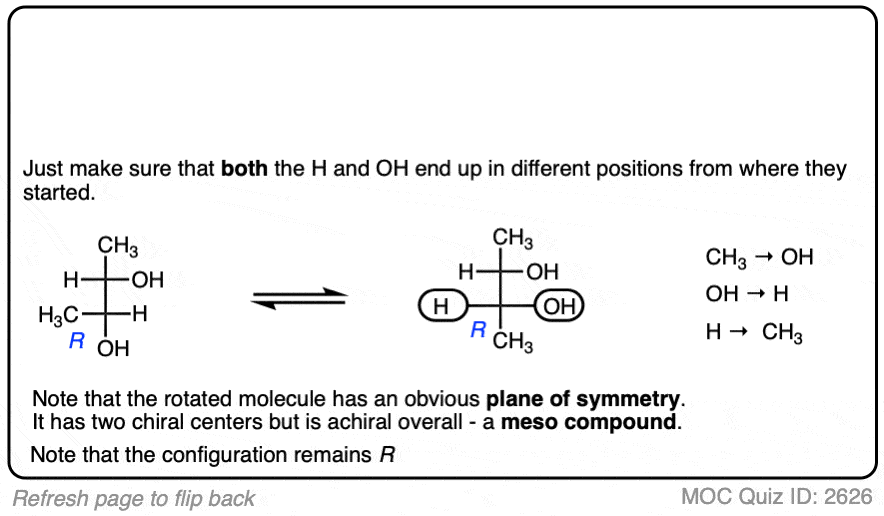
It really is as straightforward as switching around three groups (but not two!)
Do two bond rotations here. Does this reveal anything special about the molecule?
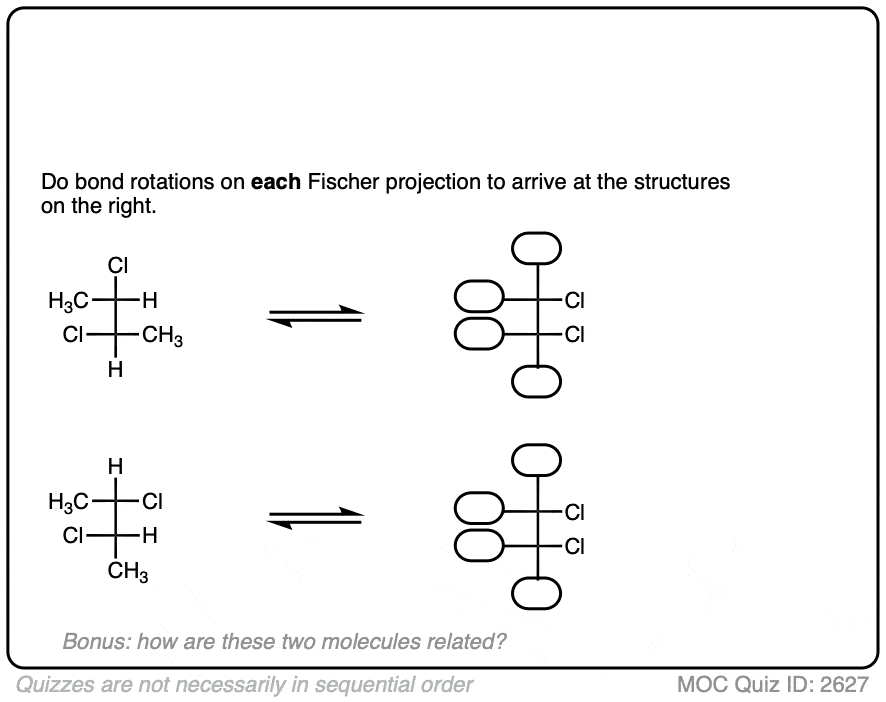 Click to Flip
Click to Flip
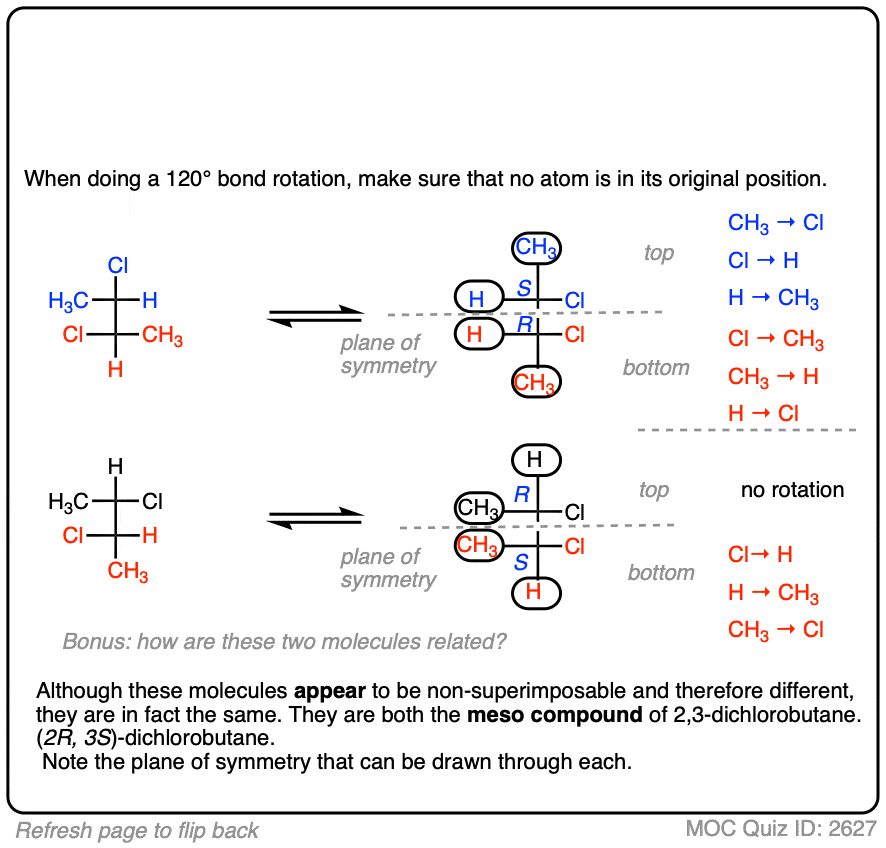
From doing all the bond rotations it should reveal that the molecule is a meso compound.
Doing bond rotations is one way of determining whether a molecule is a meso compound or not. (For more, see The Meso Trap – Identifying Meso Compounds. )
For an article on how to interchanging Newman projections via bond rotation, see Newman Projection of Butane, among others.
4. 180° Rotations: Two Templates
Life would be simpler if all bond rotations were 120° rotations.
Alas, there are times when we absolutely must do an 180° or 60° bond rotation. They are slightly more involved than doing a 120 bond rotation, but not by a lot.
The 180° is arguably more important since it results in rotating the carbon chain, so we’ll cover that first.
A good template to have by your side for these occasions is a simple tetrahedral carbon with 4 different colored atoms attached.
Just by rotating the tetrahedral carbon you will go a long way towards being able to map these rotations out in your mind.
If you don’t have a model kit handy, you can just use your fingers as a guide, even if it looks a bit like you are making gang symbols.
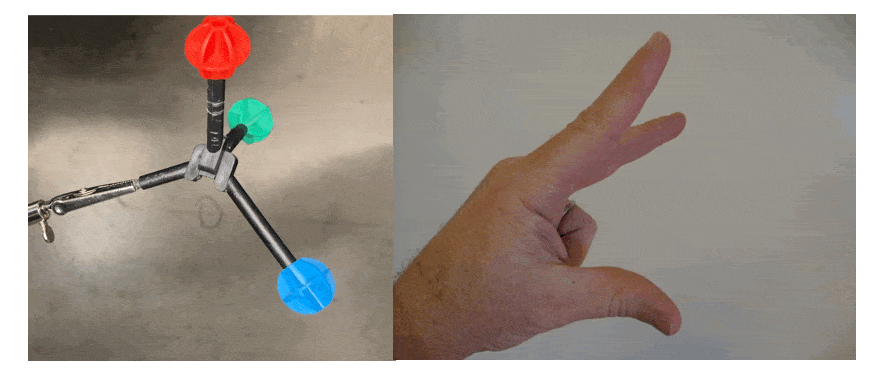
Any line drawing of a tetrahedral carbon atom will have two groups bonded to carbon that are in the plane of the page. Since we like to make line drawings where everything is flat, those groups are usually carbon atoms,
A 180° rotation is useful because it results in a rotation of the carbon chain.
There are really two key templates to examine for 180° rotations, which I will arbitrarily call the starting point a “peak” or a “valley”. [Note 1 ]

A 180° bond rotation in the first template, starting from the “peak” looks like this:
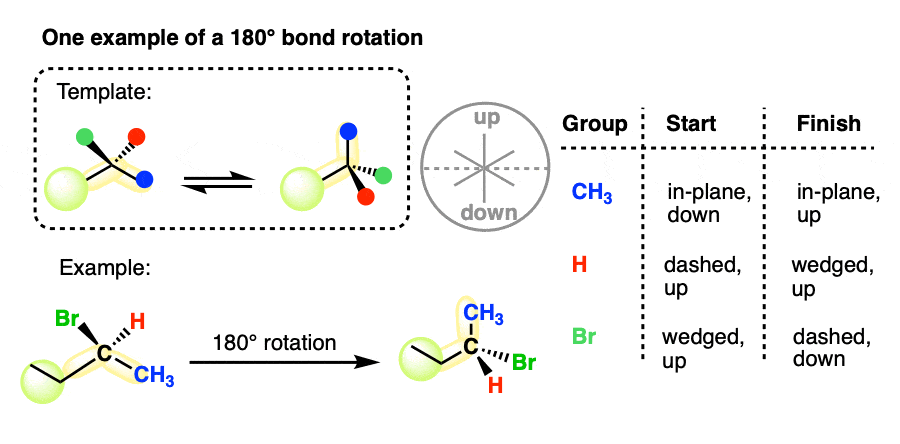
If you map out the starting positions and the end positions,
- the group that is in the plane (pointing down) remains in the plane, pointing up.
- the wedged group (pointing up) becomes dashed (pointing down)
- the dashed group (pointing up) becomes wedged (pointing down)
In practice, this rotation looks like this:

In the second template, we start with the valley (i.e. from the bottom of the zigzag in the line diagram).
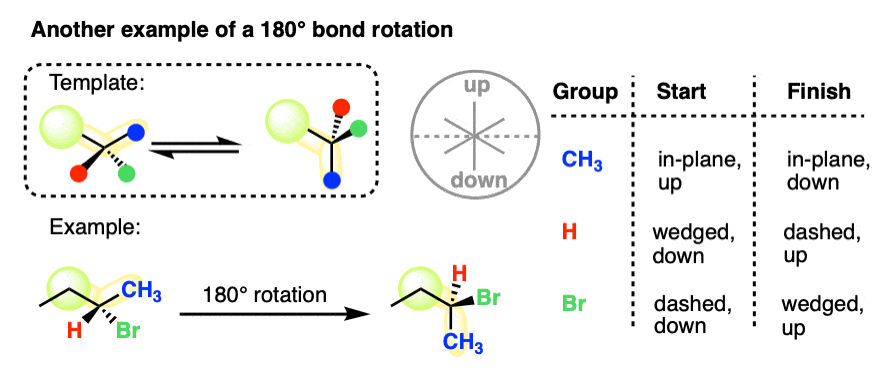
Mapping out the starting and end positions here, we get:
- the group that is in the plane (pointing up) remains in the plane, pointing down
- the wedged group (pointing down) becomes dashed (pointing up)
- the dashed group (pointing down) becomes wedged (pointing up)
This is what the rotation looks like with a model.

5. Bond Rotation Practice: 180° Rotations
OK, now let’s try doing some 180° bond rotations.
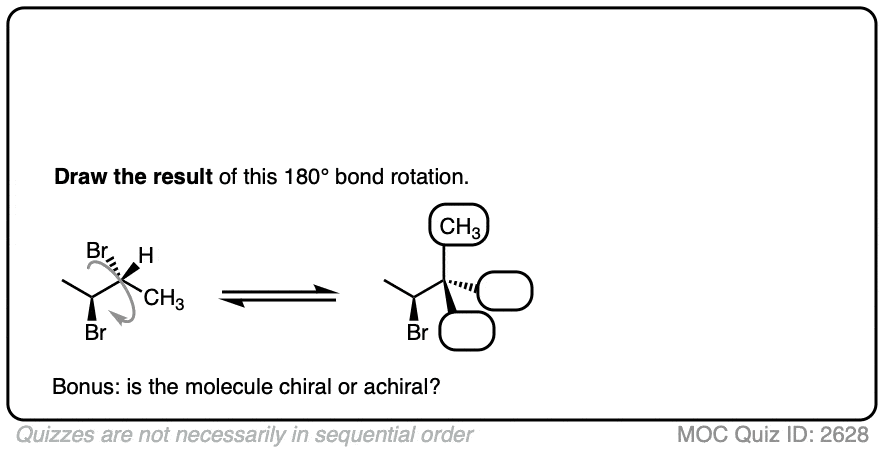 Click to Flip
Click to Flip
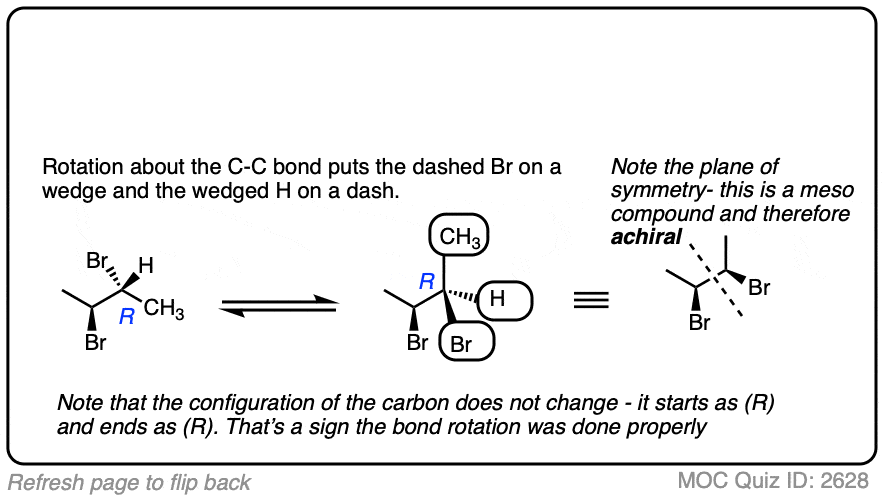
Here’s another one:
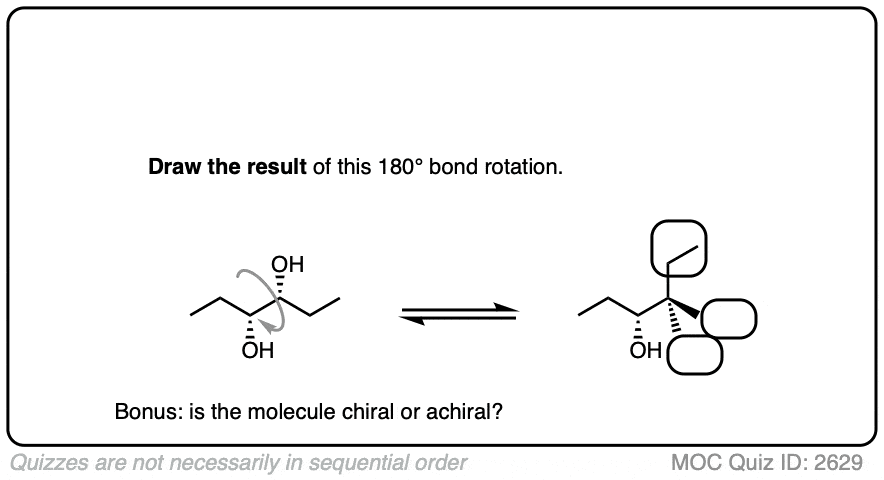 Click to Flip
Click to Flip
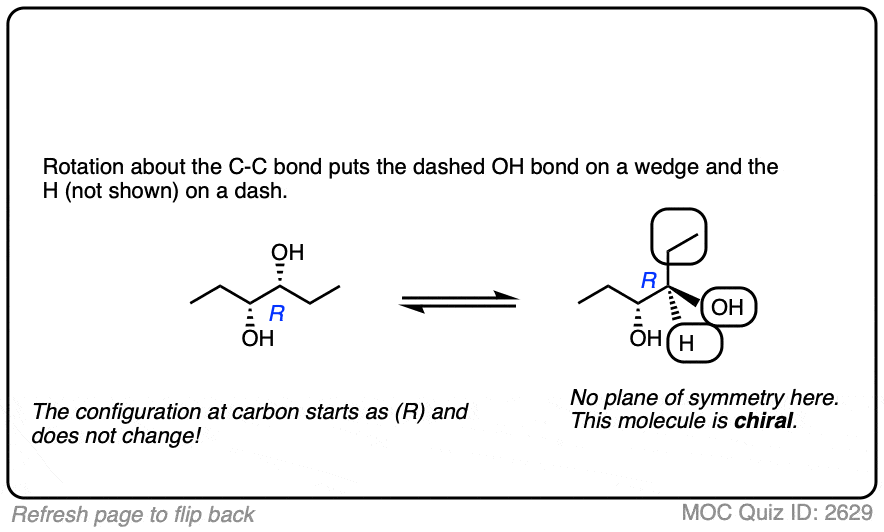
6. 60° Bond Rotations
Yes, we can also do 60° bond rotations.
There’s good news, though. If you can do a 180°, you can certainly do a 60°, since the 60° follows a similar template.
Here’s two templates, starting from a “peak” or a “valley” of the carbon chain:
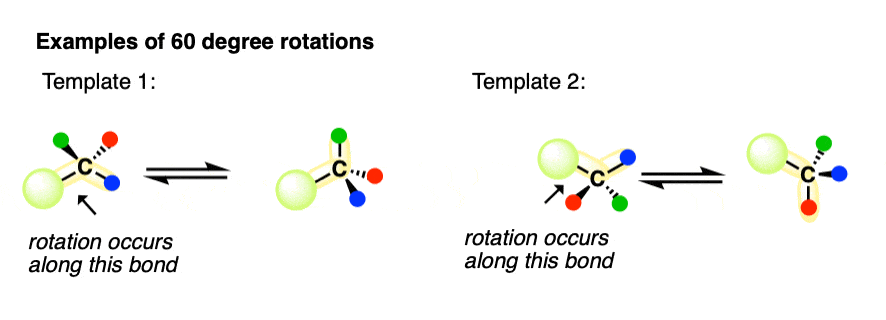
Here is an example of a 60° rotation starting from the “peak”

Here is am example of a 60° rotation starting from the “valley”:

7. Doing Multiple Bond Rotations
So far so good. We’ve shown how to do bond rotations along one carbon carbon bond. Slap yourself on the back if you’ve been successful at the exercises.
As we know, however, life can inflict cruel punishments. What if we need to do multiple bond rotations?
Yes, we could apply what we have learned above to do all those bond rotations.
But…. one starts to run into a law of diminishing returns building models, applying templates, and all that jazz.
So I present to you an alternate solution.
If you have to show the result of multiple bond rotations about a carbon chain, my advice is to do the following:
- Number your carbons.
- Determine the absolute configuration (i.e. (R)/(S)) of all chiral centers
- Redraw your carbon chain to the desired conformation
- Fill in all the substituents on the non-chiral carbons
- Put in all the substituents on the chiral carbons, and then determine (R)/(S) on each. If any of them have the wrong value, swap the dashed and wedged groups to obtain the correct configuration.
It may sound like a lot of work, but trust me, it’s less work than fudging around with models and everything else.
8. Summary
- If there’s one key trick to get out of this article, I’d say it’s just learning that swapping any 3 groups about a carbon gives you the result of a bond rotation. This alone can make the task of determining R/S when #4 is in the front or in the plane of the page significantly easier.
- Bond rotations should never result in changing the configuration about a carbon (i.e. going from (R) to (S) or vice-versa. One way to check if you’ve done a bond rotation correctly is to determine (R/S) before and after your bond rotation.
- Make sure to swap 3, since swapping two will just flip the configuration.
- Doing 180° bond rotations gets significantly easier with practice. I may suggest carrying around a single tetrahedral carbon from a model kit with 4 different substituents attached. It can come in handy for doing bond rotations and also for determining R/S. If anyone asks you what it is, just tell them it’s a piece of avant-garde sculpture or something.
- If you don’t have a model kit, just using your hands can be enough. Never forget that molecules are just 3-dimensional objects like anything else.
Notes
Related Articles
- How To Draw The Enantiomer Of A Chiral Molecule
- The Meso Trap
- Wedge And Dash Convention For Tetrahedral Carbon
- Assigning Cahn-Ingold-Prelog (CIP) Priorities (2) – The Method of Dots
- How To Determine R and S Configurations On A Fischer Projection
- Newman Projection of Butane (and Gauche Conformation)
- Introduction to Assigning (R) and (S): The Cahn-Ingold-Prelog Rules
- Types of Isomers: Constitutional Isomers, Stereoisomers, Enantiomers, and Diastereomers
- Conformational Isomers of Propane
Note 1. Only two templates, but four if you consider their mirror images where we are looking from right to left along the carbon-carbon bond. For simplicity we’re just going to omit those cases.
Quiz Yourself!
[90° rotation]
(Advanced) References and Further Reading
References
00 General Chemistry Review
01 Bonding, Structure, and Resonance
- How Do We Know Methane (CH4) Is Tetrahedral?
- Hybrid Orbitals and Hybridization
- How To Determine Hybridization: A Shortcut
- Orbital Hybridization And Bond Strengths
- Sigma bonds come in six varieties: Pi bonds come in one
- Dipole Moments and Dipoles
- A Key Skill: How to Calculate Formal Charge
- The Four Intermolecular Forces and How They Affect Boiling Points
- 3 Trends That Affect Boiling Points
- How To Use Electronegativity To Determine Electron Density (and why NOT to trust formal charge)
- Introduction to Resonance
- How To Use Curved Arrows To Interchange Resonance Forms
- Evaluating Resonance Forms (1) - The Rule of Least Charges
- How To Find The Best Resonance Structure By Applying Electronegativity
- Evaluating Resonance Structures With Negative Charges
- Evaluating Resonance Structures With Positive Charge
- Exploring Resonance: Pi-Donation
- Exploring Resonance: Pi-acceptors
- In Summary: Evaluating Resonance Structures
- Drawing Resonance Structures: 3 Common Mistakes To Avoid
- How to apply electronegativity and resonance to understand reactivity
- Bond Hybridization Practice
- Structure and Bonding Practice Quizzes
- Resonance Structures Practice
02 Acid Base Reactions
- Introduction to Acid-Base Reactions
- Acid Base Reactions In Organic Chemistry
- The Stronger The Acid, The Weaker The Conjugate Base
- Walkthrough of Acid-Base Reactions (3) - Acidity Trends
- Five Key Factors That Influence Acidity
- Acid-Base Reactions: Introducing Ka and pKa
- How to Use a pKa Table
- The pKa Table Is Your Friend
- A Handy Rule of Thumb for Acid-Base Reactions
- Acid Base Reactions Are Fast
- pKa Values Span 60 Orders Of Magnitude
- How Protonation and Deprotonation Affect Reactivity
- Acid Base Practice Problems
03 Alkanes and Nomenclature
- Meet the (Most Important) Functional Groups
- Condensed Formulas: Deciphering What the Brackets Mean
- Hidden Hydrogens, Hidden Lone Pairs, Hidden Counterions
- Don't Be Futyl, Learn The Butyls
- Primary, Secondary, Tertiary, Quaternary In Organic Chemistry
- Branching, and Its Affect On Melting and Boiling Points
- The Many, Many Ways of Drawing Butane
- Wedge And Dash Convention For Tetrahedral Carbon
- Common Mistakes in Organic Chemistry: Pentavalent Carbon
- Table of Functional Group Priorities for Nomenclature
- Summary Sheet - Alkane Nomenclature
- Organic Chemistry IUPAC Nomenclature Demystified With A Simple Puzzle Piece Approach
- Boiling Point Quizzes
- Organic Chemistry Nomenclature Quizzes
04 Conformations and Cycloalkanes
- Staggered vs Eclipsed Conformations of Ethane
- Conformational Isomers of Propane
- Newman Projection of Butane (and Gauche Conformation)
- Introduction to Cycloalkanes
- Geometric Isomers In Small Rings: Cis And Trans Cycloalkanes
- Calculation of Ring Strain In Cycloalkanes
- Cycloalkanes - Ring Strain In Cyclopropane And Cyclobutane
- Cyclohexane Conformations
- Cyclohexane Chair Conformation: An Aerial Tour
- How To Draw The Cyclohexane Chair Conformation
- The Cyclohexane Chair Flip
- The Cyclohexane Chair Flip - Energy Diagram
- Substituted Cyclohexanes - Axial vs Equatorial
- Ranking The Bulkiness Of Substituents On Cyclohexanes: "A-Values"
- Cyclohexane Chair Conformation Stability: Which One Is Lower Energy?
- Fused Rings - Cis-Decalin and Trans-Decalin
- Naming Bicyclic Compounds - Fused, Bridged, and Spiro
- Bredt's Rule (And Summary of Cycloalkanes)
- Newman Projection Practice
- Cycloalkanes Practice Problems
05 A Primer On Organic Reactions
- The Most Important Question To Ask When Learning a New Reaction
- Curved Arrows (for reactions)
- Nucleophiles and Electrophiles
- The Three Classes of Nucleophiles
- Nucleophilicity vs. Basicity
- What Makes A Good Nucleophile?
- What Makes A Good Leaving Group?
- 3 Factors That Stabilize Carbocations
- Equilibrium and Energy Relationships
- 7 Factors that stabilize negative charge in organic chemistry
- 7 Factors That Stabilize Positive Charge in Organic Chemistry
- What's a Transition State?
- Hammond's Postulate
- Learning Organic Chemistry Reactions: A Checklist (PDF)
06 Free Radical Reactions
- Free Radical Reactions
- 3 Factors That Stabilize Free Radicals
- Bond Strengths And Radical Stability
- Free Radical Initiation: Why Is "Light" Or "Heat" Required?
- Initiation, Propagation, Termination
- Monochlorination Products Of Propane, Pentane, And Other Alkanes
- Selectivity In Free Radical Reactions
- Selectivity in Free Radical Reactions: Bromination vs. Chlorination
- Halogenation At Tiffany's
- Allylic Bromination
- Bonus Topic: Allylic Rearrangements
- In Summary: Free Radicals
- Synthesis (2) - Reactions of Alkanes
- Free Radicals Practice Quizzes
07 Stereochemistry and Chirality
- Types of Isomers: Constitutional Isomers, Stereoisomers, Enantiomers, and Diastereomers
- How To Draw The Enantiomer Of A Chiral Molecule
- How To Draw A Bond Rotation
- Introduction to Assigning (R) and (S): The Cahn-Ingold-Prelog Rules
- Assigning Cahn-Ingold-Prelog (CIP) Priorities (2) - The Method of Dots
- Enantiomers vs Diastereomers vs The Same? Two Methods For Solving Problems
- Assigning R/S To Newman Projections (And Converting Newman To Line Diagrams)
- How To Determine R and S Configurations On A Fischer Projection
- The Meso Trap
- Optical Rotation, Optical Activity, and Specific Rotation
- Optical Purity and Enantiomeric Excess
- What's a Racemic Mixture?
- Chiral Allenes And Chiral Axes
- Stereochemistry Practice Problems and Quizzes
08 Substitution Reactions
- Nucleophilic Substitution Reactions - Introduction
- Two Types of Nucleophilic Substitution Reactions
- The SN2 Mechanism
- Why the SN2 Reaction Is Powerful
- The SN1 Mechanism
- The Conjugate Acid Is A Better Leaving Group
- Comparing the SN1 and SN2 Reactions
- Polar Protic? Polar Aprotic? Nonpolar? All About Solvents
- Steric Hindrance is Like a Fat Goalie
- Common Blind Spot: Intramolecular Reactions
- Substitution Practice - SN1
- Substitution Practice - SN2
09 Elimination Reactions
- Elimination Reactions (1): Introduction And The Key Pattern
- Elimination Reactions (2): The Zaitsev Rule
- Elimination Reactions Are Favored By Heat
- Two Elimination Reaction Patterns
- The E1 Reaction
- The E2 Mechanism
- E1 vs E2: Comparing the E1 and E2 Reactions
- Antiperiplanar Relationships: The E2 Reaction and Cyclohexane Rings
- Bulky Bases in Elimination Reactions
- Comparing the E1 vs SN1 Reactions
- Elimination (E1) Reactions With Rearrangements
- E1cB - Elimination (Unimolecular) Conjugate Base
- Elimination (E1) Practice Problems And Solutions
- Elimination (E2) Practice Problems and Solutions
10 Rearrangements
11 SN1/SN2/E1/E2 Decision
- Identifying Where Substitution and Elimination Reactions Happen
- Deciding SN1/SN2/E1/E2 (1) - The Substrate
- Deciding SN1/SN2/E1/E2 (2) - The Nucleophile/Base
- SN1 vs E1 and SN2 vs E2 : The Temperature
- Deciding SN1/SN2/E1/E2 - The Solvent
- Wrapup: The Key Factors For Determining SN1/SN2/E1/E2
- Alkyl Halide Reaction Map And Summary
- SN1 SN2 E1 E2 Practice Problems
12 Alkene Reactions
- E and Z Notation For Alkenes (+ Cis/Trans)
- Alkene Stability
- Alkene Addition Reactions: "Regioselectivity" and "Stereoselectivity" (Syn/Anti)
- Stereoselective and Stereospecific Reactions
- Hydrohalogenation of Alkenes and Markovnikov's Rule
- Hydration of Alkenes With Aqueous Acid
- Rearrangements in Alkene Addition Reactions
- Halogenation of Alkenes and Halohydrin Formation
- Oxymercuration Demercuration of Alkenes
- Hydroboration Oxidation of Alkenes
- m-CPBA (meta-chloroperoxybenzoic acid)
- OsO4 (Osmium Tetroxide) for Dihydroxylation of Alkenes
- Palladium on Carbon (Pd/C) for Catalytic Hydrogenation of Alkenes
- Cyclopropanation of Alkenes
- A Fourth Alkene Addition Pattern - Free Radical Addition
- Alkene Reactions: Ozonolysis
- Oxidative Cleavage of Vicinal Diols With NaIO4 and Pb(OAc)4
- Summary: Three Key Families Of Alkene Reaction Mechanisms
- Synthesis (4) - Alkene Reaction Map, Including Alkyl Halide Reactions
- Alkene Reactions Practice Problems
13 Alkyne Reactions
- Acetylides from Alkynes, And Substitution Reactions of Acetylides
- Partial Reduction of Alkynes With Lindlar's Catalyst
- Partial Reduction of Alkynes With Na/NH3 To Obtain Trans Alkenes
- Alkyne Hydroboration With "R2BH"
- Hydration and Oxymercuration of Alkynes
- Hydrohalogenation of Alkynes
- Alkyne Halogenation: Bromination and Chlorination of Alkynes
- Oxidation of Alkynes With O3 and KMnO4
- Alkenes To Alkynes Via Halogenation And Elimination Reactions
- Alkynes Are A Blank Canvas
- Synthesis (5) - Reactions of Alkynes
- Alkyne Reactions Practice Problems With Answers
14 Alcohols, Epoxides and Ethers
- Alcohols - Nomenclature and Properties
- Alcohols Can Act As Acids Or Bases (And Why It Matters)
- Alcohols - Acidity and Basicity
- The Williamson Ether Synthesis
- Ethers From Alkenes, Tertiary Alkyl Halides and Alkoxymercuration
- Alcohols To Ethers via Acid Catalysis
- Cleavage Of Ethers With Acid
- Epoxides - The Outlier Of The Ether Family
- Opening of Epoxides With Acid
- Epoxide Ring Opening With Base
- Making Alkyl Halides From Alcohols
- Tosylates And Mesylates
- PBr3 and SOCl2
- Elimination Reactions of Alcohols
- Elimination of Alcohols To Alkenes With POCl3
- Alcohol Oxidation: "Strong" and "Weak" Oxidants
- Demystifying The Mechanisms of Alcohol Oxidations
- Protecting Groups For Alcohols
- Thiols And Thioethers
- Calculating the oxidation state of a carbon
- Oxidation and Reduction in Organic Chemistry
- Oxidation Ladders
- SOCl2 Mechanism For Alcohols To Alkyl Halides: SN2 versus SNi
- Alcohol Reactions Roadmap (PDF)
- Alcohol Reaction Practice Problems
- Epoxide Reaction Quizzes
- Oxidation and Reduction Practice Quizzes
15 Organometallics
- What's An Organometallic?
- Formation of Grignard and Organolithium Reagents
- Organometallics Are Strong Bases
- Reactions of Grignard Reagents
- Protecting Groups In Grignard Reactions
- Synthesis Problems Involving Grignard Reagents
- Grignard Reactions And Synthesis (2)
- Organocuprates (Gilman Reagents): How They're Made
- Gilman Reagents (Organocuprates): What They're Used For
- The Heck, Suzuki, and Olefin Metathesis Reactions (And Why They Don't Belong In Most Introductory Organic Chemistry Courses)
- Reaction Map: Reactions of Organometallics
- Grignard Practice Problems
16 Spectroscopy
- Degrees of Unsaturation (or IHD, Index of Hydrogen Deficiency)
- Conjugation And Color (+ How Bleach Works)
- Introduction To UV-Vis Spectroscopy
- UV-Vis Spectroscopy: Absorbance of Carbonyls
- UV-Vis Spectroscopy: Practice Questions
- Bond Vibrations, Infrared Spectroscopy, and the "Ball and Spring" Model
- Infrared (IR) Spectroscopy: A Quick Primer On Interpreting Spectra
- IR Spectroscopy: 4 Practice Problems
- 1H NMR: How Many Signals?
- Homotopic, Enantiotopic, Diastereotopic
- Diastereotopic Protons in 1H NMR Spectroscopy: Examples
- 13-C NMR - How Many Signals
- Liquid Gold: Pheromones In Doe Urine
- Natural Product Isolation (1) - Extraction
- Natural Product Isolation (2) - Purification Techniques, An Overview
- Structure Determination Case Study: Deer Tarsal Gland Pheromone
17 Dienes and MO Theory
- What To Expect In Organic Chemistry 2
- Are these molecules conjugated?
- Conjugation And Resonance In Organic Chemistry
- Bonding And Antibonding Pi Orbitals
- Molecular Orbitals of The Allyl Cation, Allyl Radical, and Allyl Anion
- Pi Molecular Orbitals of Butadiene
- Reactions of Dienes: 1,2 and 1,4 Addition
- Thermodynamic and Kinetic Products
- More On 1,2 and 1,4 Additions To Dienes
- s-cis and s-trans
- The Diels-Alder Reaction
- Cyclic Dienes and Dienophiles in the Diels-Alder Reaction
- Stereochemistry of the Diels-Alder Reaction
- Exo vs Endo Products In The Diels Alder: How To Tell Them Apart
- HOMO and LUMO In the Diels Alder Reaction
- Why Are Endo vs Exo Products Favored in the Diels-Alder Reaction?
- Diels-Alder Reaction: Kinetic and Thermodynamic Control
- The Retro Diels-Alder Reaction
- The Intramolecular Diels Alder Reaction
- Regiochemistry In The Diels-Alder Reaction
- The Cope and Claisen Rearrangements
- Electrocyclic Reactions
- Electrocyclic Ring Opening And Closure (2) - Six (or Eight) Pi Electrons
- Diels Alder Practice Problems
- Molecular Orbital Theory Practice
18 Aromaticity
- Introduction To Aromaticity
- Rules For Aromaticity
- Huckel's Rule: What Does 4n+2 Mean?
- Aromatic, Non-Aromatic, or Antiaromatic? Some Practice Problems
- Antiaromatic Compounds and Antiaromaticity
- The Pi Molecular Orbitals of Benzene
- The Pi Molecular Orbitals of Cyclobutadiene
- Frost Circles
- Aromaticity Practice Quizzes
19 Reactions of Aromatic Molecules
- Electrophilic Aromatic Substitution: Introduction
- Activating and Deactivating Groups In Electrophilic Aromatic Substitution
- Electrophilic Aromatic Substitution - The Mechanism
- Ortho-, Para- and Meta- Directors in Electrophilic Aromatic Substitution
- Understanding Ortho, Para, and Meta Directors
- Why are halogens ortho- para- directors?
- Disubstituted Benzenes: The Strongest Electron-Donor "Wins"
- Electrophilic Aromatic Substitutions (1) - Halogenation of Benzene
- Electrophilic Aromatic Substitutions (2) - Nitration and Sulfonation
- EAS Reactions (3) - Friedel-Crafts Acylation and Friedel-Crafts Alkylation
- Intramolecular Friedel-Crafts Reactions
- Nucleophilic Aromatic Substitution (NAS)
- Nucleophilic Aromatic Substitution (2) - The Benzyne Mechanism
- Reactions on the "Benzylic" Carbon: Bromination And Oxidation
- The Wolff-Kishner, Clemmensen, And Other Carbonyl Reductions
- More Reactions on the Aromatic Sidechain: Reduction of Nitro Groups and the Baeyer Villiger
- Aromatic Synthesis (1) - "Order Of Operations"
- Synthesis of Benzene Derivatives (2) - Polarity Reversal
- Aromatic Synthesis (3) - Sulfonyl Blocking Groups
- Birch Reduction
- Synthesis (7): Reaction Map of Benzene and Related Aromatic Compounds
- Aromatic Reactions and Synthesis Practice
- Electrophilic Aromatic Substitution Practice Problems
20 Aldehydes and Ketones
- What's The Alpha Carbon In Carbonyl Compounds?
- Nucleophilic Addition To Carbonyls
- Aldehydes and Ketones: 14 Reactions With The Same Mechanism
- Sodium Borohydride (NaBH4) Reduction of Aldehydes and Ketones
- Grignard Reagents For Addition To Aldehydes and Ketones
- Wittig Reaction
- Hydrates, Hemiacetals, and Acetals
- Imines - Properties, Formation, Reactions, and Mechanisms
- All About Enamines
- Breaking Down Carbonyl Reaction Mechanisms: Reactions of Anionic Nucleophiles (Part 2)
- Aldehydes Ketones Reaction Practice
21 Carboxylic Acid Derivatives
- Nucleophilic Acyl Substitution (With Negatively Charged Nucleophiles)
- Addition-Elimination Mechanisms With Neutral Nucleophiles (Including Acid Catalysis)
- Basic Hydrolysis of Esters - Saponification
- Transesterification
- Proton Transfer
- Fischer Esterification - Carboxylic Acid to Ester Under Acidic Conditions
- Lithium Aluminum Hydride (LiAlH4) For Reduction of Carboxylic Acid Derivatives
- LiAlH[Ot-Bu]3 For The Reduction of Acid Halides To Aldehydes
- Di-isobutyl Aluminum Hydride (DIBAL) For The Partial Reduction of Esters and Nitriles
- Amide Hydrolysis
- Thionyl Chloride (SOCl2) And Conversion of Carboxylic Acids to Acid Halides
- Diazomethane (CH2N2)
- Carbonyl Chemistry: Learn Six Mechanisms For the Price Of One
- Making Music With Mechanisms (PADPED)
- Carboxylic Acid Derivatives Practice Questions
22 Enols and Enolates
- Keto-Enol Tautomerism
- Enolates - Formation, Stability, and Simple Reactions
- Kinetic Versus Thermodynamic Enolates
- Aldol Addition and Condensation Reactions
- Reactions of Enols - Acid-Catalyzed Aldol, Halogenation, and Mannich Reactions
- Claisen Condensation and Dieckmann Condensation
- Decarboxylation
- The Malonic Ester and Acetoacetic Ester Synthesis
- The Michael Addition Reaction and Conjugate Addition
- The Robinson Annulation
- Haloform Reaction
- The Hell–Volhard–Zelinsky Reaction
- Enols and Enolates Practice Quizzes
23 Amines
- The Amide Functional Group: Properties, Synthesis, and Nomenclature
- Basicity of Amines And pKaH
- 5 Key Basicity Trends of Amines
- The Mesomeric Effect And Aromatic Amines
- Nucleophilicity of Amines
- Alkylation of Amines (Sucks!)
- Reductive Amination
- The Gabriel Synthesis
- Some Reactions of Azides
- The Hofmann Elimination
- The Hofmann and Curtius Rearrangements
- The Cope Elimination
- Protecting Groups for Amines - Carbamates
- The Strecker Synthesis of Amino Acids
- Introduction to Peptide Synthesis
- Reactions of Diazonium Salts: Sandmeyer and Related Reactions
- Amine Practice Questions
24 Carbohydrates
- D and L Notation For Sugars
- Pyranoses and Furanoses: Ring-Chain Tautomerism In Sugars
- What is Mutarotation?
- Reducing Sugars
- The Big Damn Post Of Carbohydrate-Related Chemistry Definitions
- The Haworth Projection
- Converting a Fischer Projection To A Haworth (And Vice Versa)
- Reactions of Sugars: Glycosylation and Protection
- The Ruff Degradation and Kiliani-Fischer Synthesis
- Isoelectric Points of Amino Acids (and How To Calculate Them)
- Carbohydrates Practice
- Amino Acid Quizzes
25 Fun and Miscellaneous
- A Gallery of Some Interesting Molecules From Nature
- Screw Organic Chemistry, I'm Just Going To Write About Cats
- On Cats, Part 1: Conformations and Configurations
- On Cats, Part 2: Cat Line Diagrams
- On Cats, Part 4: Enantiocats
- On Cats, Part 6: Stereocenters
- Organic Chemistry Is Shit
- The Organic Chemistry Behind "The Pill"
- Maybe they should call them, "Formal Wins" ?
- Why Do Organic Chemists Use Kilocalories?
- The Principle of Least Effort
- Organic Chemistry GIFS - Resonance Forms
- Reproducibility In Organic Chemistry
- What Holds The Nucleus Together?
- How Reactions Are Like Music
- Organic Chemistry and the New MCAT
26 Organic Chemistry Tips and Tricks
- Common Mistakes: Formal Charges Can Mislead
- Partial Charges Give Clues About Electron Flow
- Draw The Ugly Version First
- Organic Chemistry Study Tips: Learn the Trends
- The 8 Types of Arrows In Organic Chemistry, Explained
- Top 10 Skills To Master Before An Organic Chemistry 2 Final
- Common Mistakes with Carbonyls: Carboxylic Acids... Are Acids!
- Planning Organic Synthesis With "Reaction Maps"
- Alkene Addition Pattern #1: The "Carbocation Pathway"
- Alkene Addition Pattern #2: The "Three-Membered Ring" Pathway
- Alkene Addition Pattern #3: The "Concerted" Pathway
- Number Your Carbons!
- The 4 Major Classes of Reactions in Org 1
- How (and why) electrons flow
- Grossman's Rule
- Three Exam Tips
- A 3-Step Method For Thinking Through Synthesis Problems
- Putting It Together
- Putting Diels-Alder Products in Perspective
- The Ups and Downs of Cyclohexanes
- The Most Annoying Exceptions in Org 1 (Part 1)
- The Most Annoying Exceptions in Org 1 (Part 2)
- The Marriage May Be Bad, But the Divorce Still Costs Money
- 9 Nomenclature Conventions To Know
- Nucleophile attacks Electrophile
27 Case Studies of Successful O-Chem Students
- Success Stories: How Corina Got The The "Hard" Professor - And Got An A+ Anyway
- How Helena Aced Organic Chemistry
- From a "Drop" To B+ in Org 2 – How A Hard Working Student Turned It Around
- How Serge Aced Organic Chemistry
- Success Stories: How Zach Aced Organic Chemistry 1
- Success Stories: How Kari Went From C– to B+
- How Esther Bounced Back From a "C" To Get A's In Organic Chemistry 1 And 2
- How Tyrell Got The Highest Grade In Her Organic Chemistry Course
- This Is Why Students Use Flashcards
- Success Stories: How Stu Aced Organic Chemistry
- How John Pulled Up His Organic Chemistry Exam Grades
- Success Stories: How Nathan Aced Organic Chemistry (Without It Taking Over His Life)
- How Chris Aced Org 1 and Org 2
- Interview: How Jay Got an A+ In Organic Chemistry
- How to Do Well in Organic Chemistry: One Student's Advice
- "America's Top TA" Shares His Secrets For Teaching O-Chem
- "Organic Chemistry Is Like..." - A Few Metaphors
- How To Do Well In Organic Chemistry: Advice From A Tutor
- Guest post: "I went from being afraid of tests to actually looking forward to them".
Comments
Comment section